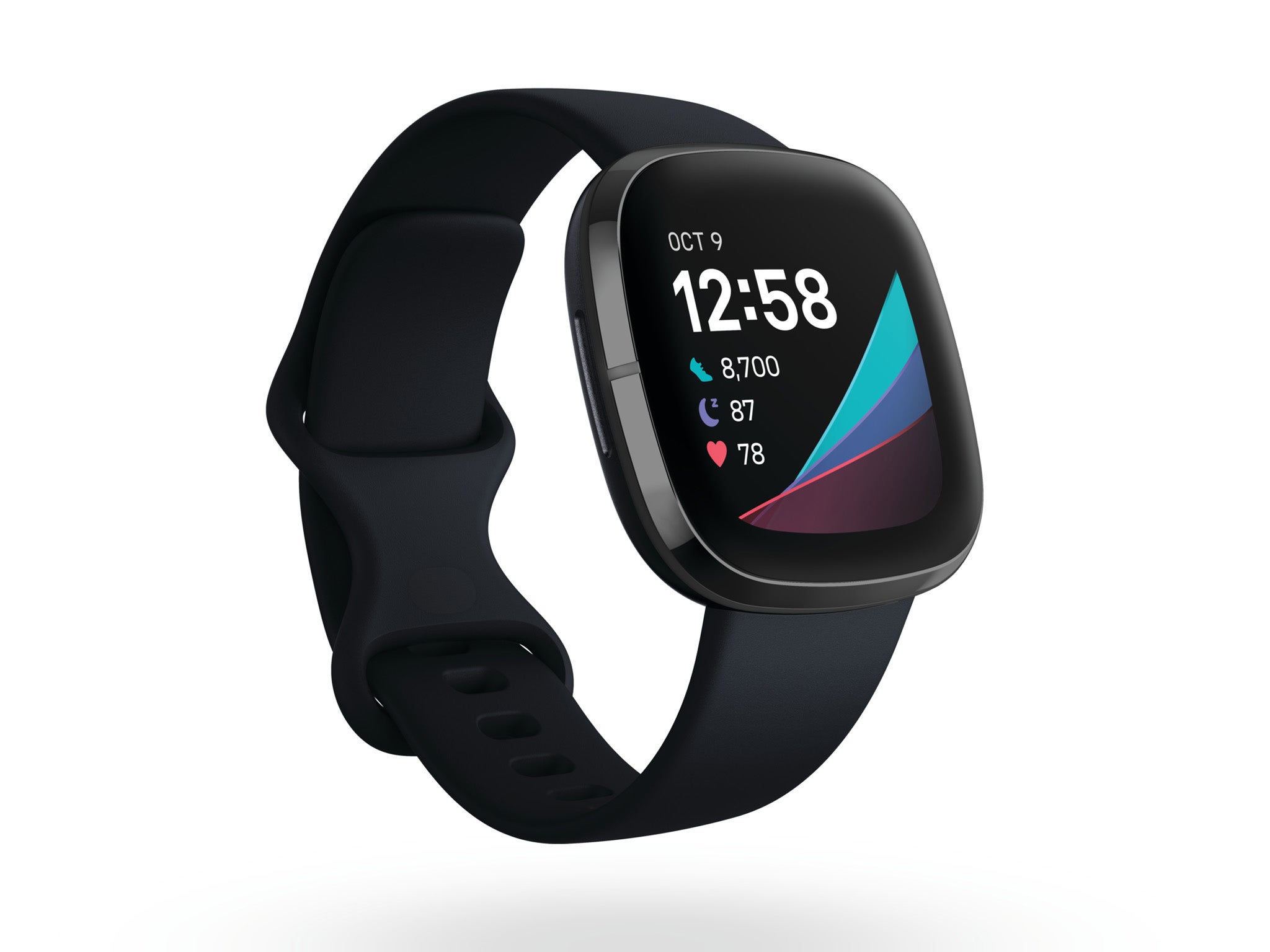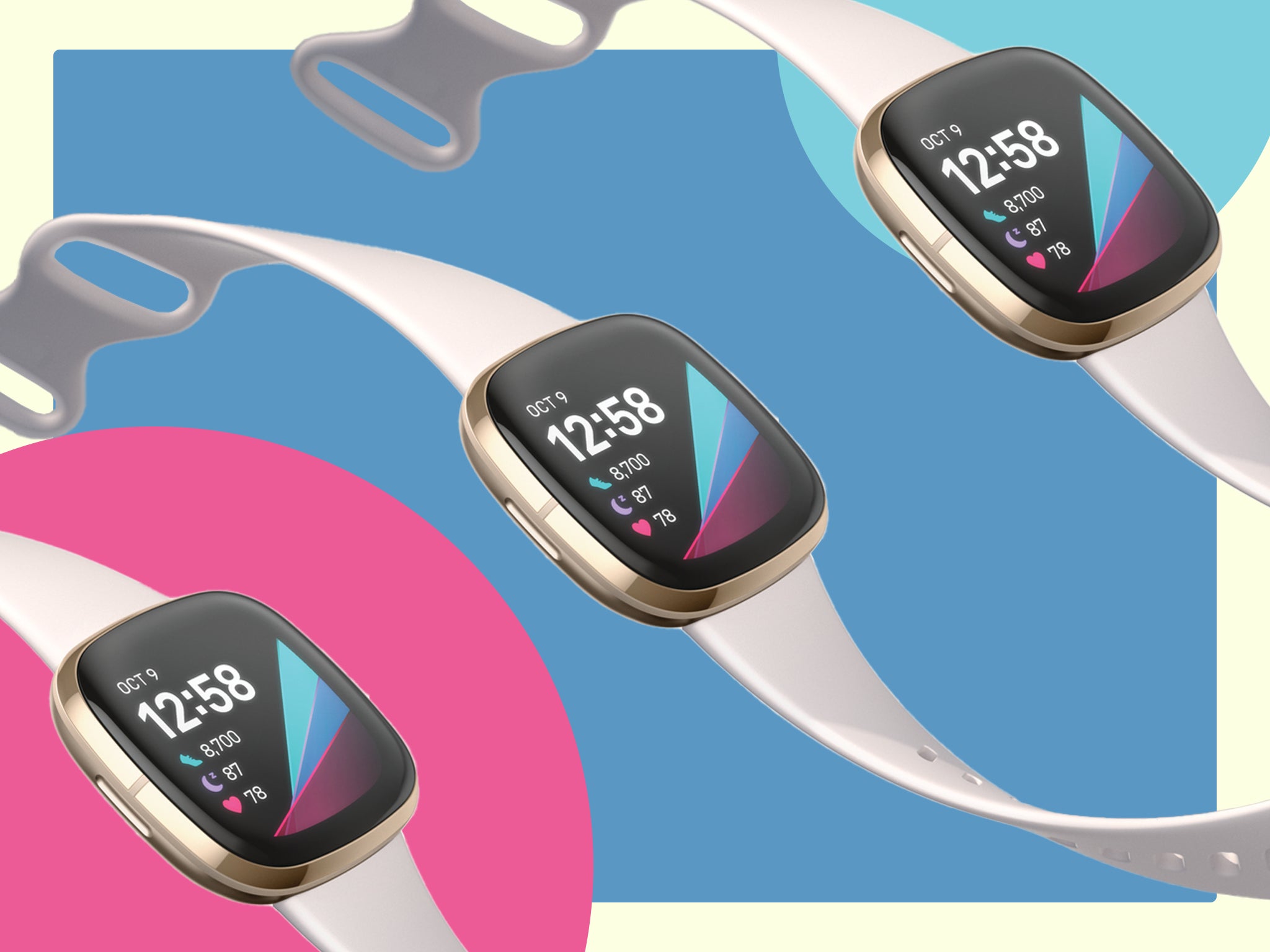Fitbit Sense

Buy now £199.99, Fitbit.com
- Assistant: Alexa, with Google Assistant most likely incoming
- Useful features: ECG sensor, EDA scanner, SpO2 tracker, skin temperature sensor, guided mindfulness and breathing sessions, sleep tracker, menstrual health tracking, music capability, Bluetooth call and message/app notifications.
- Rating: 9/10
Design
Fitbit’s design team has improved enormously upon initial models. What was once a range of thin, clunky fitness bands now includes an impressive array of refined wearables, with the Sense near the top of the list. It shares many design elements with the brand’s Versa 3, the soft edges and screen size major advantages.
However, our Sense’s added stainless steel edge (gold is also available) elevates an already-premium aesthetic and somehow lends it a lighter feel than the Versa 3, despite having the same dimensions. The indented side button is a nice touch compared to the more prevalent jutting-out button you see elsewhere, and helps the Sense retain its symmetrical aesthetic, but a level of inconsistency does mean that you might have to press a couple of times in order for it to work. We think that’s a small price to pay.
Read more: Fitbit Versa 3 vs Fitbit Sense
The screen’s Gorilla Glass offers a super clear face, perfect for Fitbit’s huge range of clock faces and a worthy protector of the AMOLED screen underneath. The Sense is also one of the comfiest smartwatches we’ve ever worn. The strap is easy to use and supremely comfortable, especially for rubber, and the face size is in the goldilocks zone of versatility – we could see this working for everyone from bodybuilders to ballerinas.
The battery life comes out at around six days, favourable when compared to most rivals and a marathon runner in comparison to Apple.
Features
To get the most out of many of the tools and features on offer, Fitbit premium is required: you usually get six months free premium with a new Sense, and it’s worth taking them up on the offer to see if the wider tools accessible are worth the future monthly subscription.
This has been emphasised even further by Fitbit’s partnership with and six-month free subscription to the Calm app. Without premium, however, there’s still plenty to get your teeth stuck into and a high level of detailed information on your health, especially on the stress-management side of things. Guided mindfulness and breathing sessions work well in tandem with the Fitbit app to encourage you to take conscious moments out of your day to find some calm.
Read more: 10 best Garmin watches for every activity
One neat feature is the EDA sensor: by tracking “electrodermal activity” – the small, subtle electrical changes in the sweat level on your skin – the Sense offers another way of tracking stress and strain. Although we have no idea how it works, it certainly made us more aware of daily stress levels and the dangers of a regularly high stress base.
The oxygen saturation tracker is a great feature, something that is particularly handy when it comes to respiratory illnesses and conditions like asthma. The ECG sensor now customary with any high-end tracker works well enough too, although, as with the EDA sensor, there’s certainly room for improvement when it comes to sensitivity and consistency (at least we hope it’s this and not our dodgy ticker).
Alongside the ECG, more sophisticated heart monitoring makes it possible to pick up on potential atrial fibrillation, notify you of low and high heart readings, and train using heart rate zones, providing real-time stats on each fitness session. Of course, all of this is no replacement for actual medical consultation, but is a handy way of keeping track of heart health.
Read more: Withings Pulse HR review: A simple fitness tracker with a 20-day battery life
While Fitbit is obviously fitness-focused (it’s in the name, after all), the Sense’s more general smartwatch features deserve a mention. There are plenty of decent apps to download, including music control – the Spotify app, for instance, is a clean if basic bit of software that does exactly what you need of it.
Fitbit pay also works without a hitch, if contactless payments are your sort of thing, and the Sense is Google Assistant and Alexa compatible. Calls and other notifications are nicely set out on the generous screen, and Android users can send quick text and voice replies straight from the Sense.
The verdict: Fitbit Sense
The Fitbit Sense is the smartwatch for the not-as-yet-roaring Twenties, a valuable partner on your wrist that will help navigate the stresses of our current lives and help you stick to your fitness goals. There are things to improve: sensor sensitivity has scope to be ramped up, the side button isn’t the most reliable and there are the usual bugs and app issues present with any quickly developing tech product.
However, anyone looking for a more health-focused wearable would be wise to think seriously about investing in the Sense, especially at its current price. Even at the original RRP, the Sense’s breadth of features arguably justified the price point. There’s no argument now.

